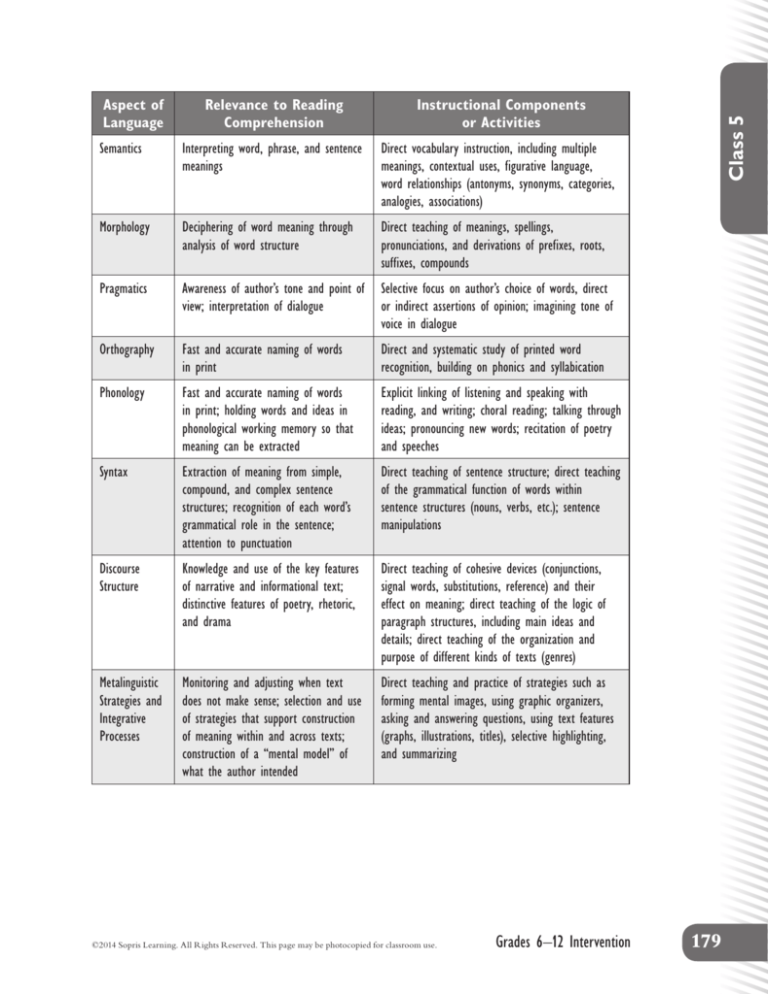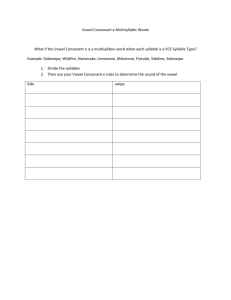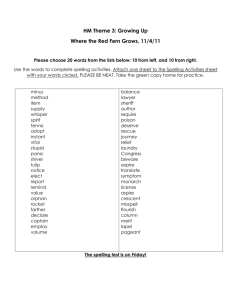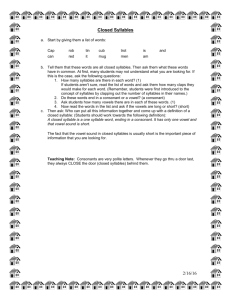
Relevance to Reading
Comprehension
Instructional Components
or Activities
Semantics
Interpreting word, phrase, and sentence
meanings
Direct vocabulary instruction, including multiple
meanings, contextual uses, figurative language,
word relationships (antonyms, synonyms, categories,
analogies, associations)
Morphology
Deciphering of word meaning through
analysis of word structure
Direct teaching of meanings, spellings,
pronunciations, and derivations of prefixes, roots,
suffixes, compounds
Pragmatics
Awareness of author’s tone and point of
view; interpretation of dialogue
Selective focus on author’s choice of words, direct
or indirect assertions of opinion; imagining tone of
voice in dialogue
Orthography
Fast and accurate naming of words
in print
Direct and systematic study of printed word
recognition, building on phonics and syllabication
Phonology
Fast and accurate naming of words
in print; holding words and ideas in
phonological working memory so that
meaning can be extracted
Explicit linking of listening and speaking with
reading, and writing; choral reading; talking through
ideas; pronouncing new words; recitation of poetry
and speeches
Syntax
Extraction of meaning from simple,
compound, and complex sentence
structures; recognition of each word’s
grammatical role in the sentence;
attention to punctuation
Direct teaching of sentence structure; direct teaching
of the grammatical function of words within
sentence structures (nouns, verbs, etc.); sentence
manipulations
Discourse
Structure
Knowledge and use of the key features
of narrative and informational text;
distinctive features of poetry, rhetoric,
and drama
Direct teaching of cohesive devices (conjunctions,
signal words, substitutions, reference) and their
effect on meaning; direct teaching of the logic of
paragraph structures, including main ideas and
details; direct teaching of the organization and
purpose of different kinds of texts (genres)
Metalinguistic
Strategies and
Integrative
Processes
Monitoring and adjusting when text
does not make sense; selection and use
of strategies that support construction
of meaning within and across texts;
construction of a “mental model” of
what the author intended
Direct teaching and practice of strategies such as
forming mental images, using graphic organizers,
asking and answering questions, using text features
(graphs, illustrations, titles), selective highlighting,
and summarizing
©2014 Sopris Learning. All Rights Reserved. This page may be photocopied for classroom use.
Grades 6–12 Intervention
Class 5
Aspect of
Language
179
4
A Comprehension Instruction
Framework
Class 5
Section
Goal—Teachers Will
• Learn and begin to apply a comprehension instruction framework.
Comprehension Instruction Framework
(Adapted from Moats & Hennessy, 2010)
Summarize the critical or enduring
understandings
What do you want students to know, understand, and/or do after reading
the text?
Identify your purpose
What is the author’s purpose in writing the text (e.g., to inform, entertain,
persuade)? Why are you asking the students to read it?
Identify key vocabulary
Which 10–15 words will be most important to teach directly and explicitly?
Which words will you incidentally teach? When, and in what way?
Segment the text; mark
spots where questions and
comprehension checks are needed
during reading
Where are the pivotal points in the text that beg for questioning or
checking comprehension and summarizing what’s understood so far?
Identify challenging language
Does the text contain figurative language, obscure uses of familiar terms,
complex sentence structures, or unclear references that may be challenging
for your students? How and when will you work with these?
Prepare text introduction
What background knowledge is necessary for understanding what is in the
text? What will you do to help students acquire sufficient prior knowledge
and make connections to experiences outside the text? How will you teach the
students to use the text’s structure to organize their search for meaning?
Plan text reading
What strategies and activities (including questions) will you use to facilitate
students’ literal comprehension, understanding of underlying ideas, and
integration of meanings within the text and across texts—before, during, and
after reading? How will you conduct first, second, or even third readings?
Have students express
understanding
What strategies and activities will you use to have students demonstrate
understanding at different levels?
©2014 Sopris Learning. All Rights Reserved. This page may be photocopied for classroom use.
Grades 6–12 Intervention
187
Class 5
Word Knowledge Rating Chart
Use this chart to introduce 10–12 important words from the text you will be reading.
As you pronounce, write, provide contextual examples, and give a definition for each
word, students fill in the chart by writing the word, rating their knowledge of it, writing
the definition, and then illustrating the meaning in any way that they think will be
helpful to them.
Key:
0
1
2
3
=
=
=
=
I’ve never heard it.
I’ve heard it before.
I can use it in a sentence.
I know it.
Word Knowledge Rating Chart
Vocabulary
Word
Knowledge
Rating
Definition
Picture
0 1 2 3
0 1 2 3
0 1 2 3
0 1 2 3
0 1 2 3
0 1 2 3
0 1 2 3
0 1 2 3
(Moats, 2014)
©2014 Sopris Learning. All Rights Reserved. This page may be photocopied for classroom use.
Grades 6–12 Intervention
193
Multiple-Meaning Map
This graphic organizer is valuable for either introducing an unusual meaning and use of a known word before reading, or revisiting
and deepening word knowledge after reading. The organizer is designed to support classroom conversation and group brainstorming.
An example of a multiple-meaning word is conduct. Not only is it either a noun or a verb, depending on its stress pattern, but it has
several very different meanings.
(Moats, 2014)
©2014 Sopris Learning. All Rights Reserved. This page may be photocopied for classroom use.
TNCore
194
Advanced Four-Square Organizer
Synonyms:
Antonyms:
Examples
Non-examples
Definition:
Related words
Figurative language
(Moats, 2014)
196
TNCore
©2014 Sopris Learning. All Rights Reserved. This page may be photocopied for classroom use.
Word
Category
=
Attributes
+
Definition:
Word
Category
=
Attributes
+
Definition:
Word
Category
=
Attributes
+
Definition:
Word
Category
=
Attributes
+
Definition:
Word
Category
=
Attributes
+
Definition:
(Moats, 2014)
198
TNCore
©2014 Sopris Learning. All Rights Reserved. This page may be photocopied for classroom use.
Estimated
Difficulty Level*
Purpose for
Reading
“Take Aways” or Enduring
Understandings
Class 5
Name of
Text Selection
Text #1
Pre-taught Vocabulary for Text #1:
Text #2
Pre-taught Vocabulary for Text #2:
Text #3
Pre-taught Vocabulary for Text #3:
*Any acceptable method can be noted here (e.g., Lexile, DRP, grade level, Reading A-Z).
The naming of commonly used assessments or other resources cited in the materials is by no
means an exhaustive list of examples. The Tennessee Department of Education does not endorse
or promote specific vendors.
©2014 Sopris Learning. All Rights Reserved. This page may be photocopied for classroom use.
Grades 6–12 Intervention
203
Appendix A: Four-Square Organizer
1. Definition
3. Non-examples
204
TNCore
2. Examples
4. Characteristics
(or picture)
©2014 Sopris Learning. All Rights Reserved. This page may be photocopied for classroom use.
Comprehension Instruction Framework
(Adapted from Moats & Hennessy, 2010)
Summarize the critical or
enduring understandings
Class 6
Identify your purpose
Identify key vocabulary
Segment the text; mark
spots where questions
and comprehension
checks are needed
during reading
Identify challenging
language
Prepare text introduction
Plan text reading
Have students express
understanding
©2014 Sopris Learning. All Rights Reserved. This page may be photocopied for classroom use.
Grades 6–12 Intervention
249
Appendix A: Problem/Solution Graphic Organizer
Cause or Context
Problem
Possible Solution
Current Effect or
Consequence
Likely Effect or Result
1.
1.
2.
2.
3.
3.
Optional/Opinion: What did happen or what should happen? Was/is there a
best solution?
250
TNCore
©2014 Sopris Learning. All Rights Reserved. This page may be photocopied for classroom use.
A Procedure for Irregular, High-Frequency Words
(Method 1: Tiles or Cards)
Odd and truly unpredictable spellings—such as of, who, said, and does—constitute
a small percentage of English words and are generally descendants of Old English or
Anglo-Saxon words. Unfortunately, these words are over-represented among the words
most often used for writing, and are a continuing source of frustration for weak spellers.
Traditionally, these words have been called “outlaw,” “lookout,” “red,” or “tricky” words.
Irregular, high-frequency words should be taught a few at a time, and then practiced
over extended periods until correct spelling habits are formed. When words cannot be
taught by pattern, their visual-orthographic images can be reinforced with these five steps:
1. Spell the word with letter tiles or index cards with letters written on them.
2.Ask students to say the letters and form an image of the word with their
mental “cameras.”
3.Turn over the cards so that the letters are facing down. Ask students to identify the
letters in random order. Turn each card face-up as a student names the letter.
4.Turn over the cards and hide the letters again. Ask students to identify the letters
in reverse order. Turn each card face-up as a student names the letter.
5.Ask students to spell the word correctly and write it from memory.
6. Immediately dictate a phrase or sentence with the word.
the
a
have
of
off
one
only
do
to
two
does
was
270
TNCore
were
there
they
are
says
said
again
you
your
want
who
any
many
been
what
where
some
come
from
other
through
put
push
pull
door
their
often
very
would
could
should
friend
walk
talk
love
gone
©2014 Sopris Learning. All Rights Reserved. This page may be photocopied for classroom use.
Appendix B: Spelling Scope and Sequence
This is a flexible scope and sequence meant to convey an outline of the general
progression of language structures to be taught. Some students can progress faster; others
must go more slowly. Note that the pace of teaching correspondences for reading is faster
than the pace for spelling, especially for students with spelling disabilities.
(From Moats, 2012)
Ending
consonants
Digraphs
Beginning
blends
Ending
blends
Silent
letters
Short
vowels
(closed
syllables)
Vowel
teams and
diphthongs
Open
syllables
(single long
vowels)
Grade
2
ce, ci, cy =
/s/
ge, gi, gy
= /j/
Grade
3
Grade
4
ph, gh =
/f/
ch = /k/
s(t), -bt,
-mn
ps, rh
-ch, -tch
Grades
7–8
shr, thr, scr,
squ, spl, spr,
str
cks, x
a, e, i, o, u
e, o
y = /ī/
Grade
6
ff, ll, ss, zz
(Floss rule);
-ge, -dge
kn, gn, wr,
lk
ee, ea, oa,
ai, ay
Grade
5
Class 7
Beginning
single
consonants
Grade
1
b, d, f, g,
h, j, c, k, l,
m, n, p, qu,
r, s, t, v, w,
y, z
b, d, g, l,
m, n, p, r,
t, x
/z/ = s, z
/v/ = -ve
sh, th, ch,
wh, ng, -ck
consonant
+ /l/ or
/r/; sk, st,
sl, sm, sn,
sp, sw
mp, st, nd,
nk, ft, lt, lf
y = /ĭ/
igh; au, aw; eu, ew, ue,
oi, oy; ou,
ui, eight,
ow; oo
ough, aigh
a, e, i, o, u,
y = /ē/
(cont)
©2014 Sopris Learning. All Rights Reserved. This page may be photocopied for classroom use.
Grades 6–12 Intervention
297
Grade
1
Vowel(introduce
Consonant-e concept)
Vowel-r
er, ar, or
-ing, -ang,
-ung; -ink,
-ank, -unk;
-all
Inflections /s/, /z/ =
and ending plural -s,
rules
-ing, -en
Grade
Grade
2
3
a_e, i_e,
ore, are,
o_e, u_e,
ure, ire, ere
e_e
oar, air, ear;
war, wor
Grade
4
Grade
5
Grade
6
Grades
7–8
auto-,
phono-,
hemi-,
mono-,
hyper-,
chron-graph,
-meter,
-sphere,
-scope
cred, duc/
duct, pel,
puls, fac/fic/
fect, vert/
vers, capit/
capt, cept/
cap/ceiv
Assimilated
prefixes
(com/con/
col/cor)
Rime
chunks
Prefixes
Derivational -y, -ish,
suffixes
-able
/t/, /d/, /ed/
= ed; er,
est (no base
change);
doubling
rule, drop
“e” rule
un-, re-,
mis-
Change “y”
to “i” rule;
doubling
rule, drop
“e” rule,
multisyllable
words
dis-, in-,
ex-, con-,
com-, per-
Change “y”
to “i” rule;
doubling
rule, drop
“e” rule,
multisyllable
words
bi-, tri-,
uni-, circum-,
inter-, super-,
mal-, trans-,
intra-
-less, -ness,
-ful, -ly,
-ment
-tion, -ive,
-age, -ic,
-ity, -ible
-ology,
-sion, -ary,
-or, -al
[various
Latin and
Greek
prefixes]
[various
Latin and
Greek
suffixes]
Base words, [compounds] [contractions] [multisyllabic port, form, flect/flex,
roots
[base words Anglo-Saxon tract, script, ped/pod,
whose forms base words] rupt, spect, mit/miss,
do not
struct, ject, tend/tens,
change when
dict
ten/tain,
endings are
pic/ply, fer,
added]
aud, vis
298
TNCore
pend/pens,
pos/pon/
pose, sist/
sta/stat
©2014 Sopris Learning. All Rights Reserved. This page may be photocopied for classroom use.
Appendix C: Sentence Builder Chart
How many?
Which ones?
What kind?
(Noun)
Is/was
doing,
thinking,
feeling?
(Verb)
To whom?
To what?
For whom?
With what?
What?
Where?
When?
How?
Why?
(Indirect
object)
(Noun
phrase)
(Direct
object)
(Preposition
or adverbial
phrase)
Class 7
(Adjective)
Who?
What?
©2014 Sopris Learning. All Rights Reserved. This page may be photocopied for classroom use.
Grades 6–12 Intervention
299
Appendix E: An Argument Framework
Assertion or Opinion
Major Cause or Reason
Contributing
Reason
Contributing
Reason
Class 7
Contributing
Reason
Closing Statement
©2014 Sopris Learning. All Rights Reserved. This page may be photocopied for classroom use.
Grades 6–12 Intervention
301
Example Instructional Sequence
(Created by Louisa C. Moats)
Phoneme-Grapheme Correspondences, Syllable Patterns,
and Morphemes in English Orthography
Expected by End
of Grade Level
Reading Spelling
Consonant phonemes represented with single letters: m, s, t, l; p, f, c (/k/), n; b, r, j,
k; v, g (/g/), w, d; h, y, z, x
K
K
Short vowels /ă/ /ĭ/ /ŏ/ /ŭ/ /ĕ/ spelled with a, i, o, u, e
K
K
Encode and decode simple syllables with short vowels (VC, CVC)
K
K
Long vowel sounds associated with single letters a, e, i, o, u; open syllables in onesyllable words me, he, be; so, no; hi, by
K
K
A few transparent consonant blends: qu, st, sm, sn, -st, -ft, lp
K
1
Consonant digraphs sh, ch, wh, th, ng
1
1
Consonant trigraphs, with and without digraphs (watch, judge)
2
2
Concept of closed syllable needing consonant guards to keep the vowel short
1–3
1–3
Concept of open syllable with no guards, allowing vowel to be long
1–3
1–3
1
1
1–2
2–3
Identify base word and inflectional suffix on single-syllable base words with no spelling
change (help, helps, helped, helping)
1
1
VCe long vowel pattern in single syllable words (wage, theme, fine, doze, cute/rude)
1
2
1–3
1–3
Most common vowel teams for long vowel sounds (ee/ea; ai/ay; oa/ow/oe; igh)
1
1–2
Diphthongs /oi/ (oi, oy), /ou/ (ou, ow); odd vowels /aw/ (au, aw), // (oo, u) (boil,
boy, shout, now, cause, saw, book, put)
1
2
Concept of vowel team syllable type in multi-syllable words
2–3
2–3
Generalization of position-based vowel spelling patterns such as ai, ay in onesyllable words
—
2
1
2–3
Two or more spellings for certain sounds: /s/ = c, s /z/ = s, z /k/ = k, c, -ck
after a short vowel /j / = j, g
Principle of hard and soft c and g (carry, cent; girl, gentle)
Concept of VCe syllable type in multi-syllable words
Vowel + r patterns, /er/ = ir, ur, er /ar/ = ar /or/ = or and Vowel + r
syllable type
©2014 Sopris Learning. All Rights Reserved. This page may be photocopied for classroom use.
Grades 6–12 Intervention
303
Phoneme-Grapheme Correspondences, Syllable Patterns,
and Morphemes in English Orthography
Expected by End
of Grade Level
Reading Spelling
All jobs of y (y as consonant /y/; as /ī/ on ends of one-syllable words like cry; as /ē/
on ends of multi-syllable words like baby; as /ĭ/ in a few words like gym, myth)
1
2
“Floss” or f, l, s, z doubling rule (stuff, well, miss, jazz)
1
1
Encode and decode single syllable words with blends, digraphs, short vowels, long
vowel, and vowel + r patterns that have been taught
1–2
1–2
Application of spelling principle of more consonants after short vowels (-dge, -tch,
-ck, etc.)
—-
2–3
Additional consonant digraphs ph, gh (phone, cough)
2
2–3
The -ild, -ost, -old, -olt, -ind pattern (wild, most, cold, dolt, hind)
2
2
Less common vowel teams: ei, eigh (vein, eight); ie (thief ); ie, igh (pie, fight)
2
2
The sounds /ū/ and /yū/ have overlapping but different spelling patterns (music/stupid;
cute/rude; few/chew; cue/clue; suit, soup, moon)
2
2–3
Less common vowel + r spellings with vowel teams and VCe: are, air, aire, eir; ore,
our, oor; ear, eer, ier; ire; ure
2
2–3
Contractions with am, is, has, not (I’m, he’s, she’s, isn’t, don’t)
1
2
Contractions with have, would, will (I’ve, he’d, they’ll)
2
3
Common silent letter patterns from Anglo-Saxon (kn, mb, -lk, gn, wr, gh) (know, comb,
talk, gnat, write, ghost)
2
3+
Division of multi-syllable words with two closed syllables and VCCV letter sequence
(napkin, rabbit, helping)
1
2
Two and three-syllable words with regular syllable types (closed, VCe, open, vowel team,
vowel + r)
2
2–3
Consonant -le syllable type (stable final syllable) on multisyllabic words
(bugle, snuggle)
2
3+
Multi-syllable word construction and division principles, VC/CV, V/CV, VC/V, CV/VC
2-3
3+
Pattern for plural -s, pronounced /s/ and /z/, and -es after /s/, /z/, /ch/, /j/,
/z/, /zh/)
1
2
Possessive singular (house’s )
1
2
Possessive plural (houses’ )
2
(cont)
304
TNCore
©2014 Sopris Learning. All Rights Reserved. This page may be photocopied for classroom use.
Phoneme-Grapheme Correspondences, Syllable Patterns,
and Morphemes in English Orthography
Expected by End
of Grade Level
Reading Spelling
Three sounds for the past tense -ed (walked /t/, hummed /d/, wanted /ed/)
1
2–3
Identification of syllable stress and schwa (wagon, ticket, music, along)
2
2–3
Irregular plurals and irregular past tense verb forms (wolf, wolves; deer, deer; ran, run;
leave, left; sell, sold)
1–2
2–3+
Consonant doubling rule for one-syllable words (sit, sitting)
2–3
3+
Drop silent e spelling rule for one-syllable words (hope, hoping)
2–3
3+
Change y to i spelling rule for one-syllable words (cry, cries)
2–3
3+
Final syllables beginning with ti, ci, si (nation, special, vision)
3–4
4+
Spellings dependent on language of origin of a word (etymology), such as Greek ph /f/,
ch /k/, y /ĭ/; French ch for /sh/, g for /zh/ (machine, garage or rouge)
2–3
3
1–2
2–3
Common inflectional suffixes on base words (-s, -ed, -ing, -er, -est )
1
2–3
Most common prefixes:
closed and vowel-r syllables: non, ex, con, per, mal
open syllables: bi, co, di, o, pro, tri, twi, pre
two syllables: super, circum, intra, contra, counter, extra, intro, multi, ultra
2
3
Common suffixes beginning with a consonant (-ly, -ful, -ment, -hood, -less, -ness)
2
3
More prefixes (fore, inter, trans, over, sub, semi, anti, mid, ex, post )
3
3–4
Suffixes with ti, ci, si (tion, sion, tious, sious, cial, tial), suffix -ture
3
4
4+
4+
Morphology (Meaningful Word Parts)
Anglo-Saxon compounds with closed, open, and VCe syllables (starlight, daytime)
Common suffixes beginning with a vowel (-y, -er, -or, -en, -able/ible)
Common Latin roots:
port, form, rupt, script, tract, cept
spect, ject, struct, dict, mit, flex, fer
cred, duc, pend, pel, fac, vert, tend
curs, ped, vid, aud, vit/viv
leg, greg, cap/cieve/cep, grad/gress
voc/voke, leg/lect, lit/litera
cede/cess, tain/ten/tin, fid/fide/feal
sis/sta/stat, cad/cas/cid, pon/pose
cern/cert, mob/mot/mov, gen/genus
cid, cis
©2014 Sopris Learning. All Rights Reserved. This page may be photocopied for classroom use.
Grades 6–12 Intervention
305
Phoneme-Grapheme Correspondences, Syllable Patterns,
and Morphemes in English Orthography
Expected by End
of Grade Level
Reading Spelling
306
Assimilated prefixes:
in (immigrate, illegal, irregular )
ad (address, approach, aggressive )
ob (obstruct, opportunity )
sub (subtract, suppose, surround )
com (commit, collide, corrode )
dis (dissuade, difference )
4+
4+
More Derivational suffixes:
most, ous, or, ess, ure/ture, dom, ent/ence, an, ant/ance, ist, ic, ty
ar, ability, ible/ibility, ize, ary, ate, ward, age, al, ify, ity, ee, fy
ism, ious, ory, ial, ian, cious, ation, ial, tious, ile, ade, ium
5+
5+
Connectives that join the root and suffix:
i (menial, lenient, anxious) and u (superfluous, disingenuous, factual )
5+
5+
Greek morphemes and combining forms:
Graphemes unique to Greek-based words
ch = /k/ (chorus, monochrome )
y = [i] or [ī] (dyslexia, cytoplasm )
ph = /f/ (phonology, grapheme )
x = /z/ (xylophone )
Silent letter spellings
rh (rheumatoid )
ps (psychology )
pn (pneumonia )
mn (mnemonic )
pt (pterodactyl )
Combining forms
micro, scope, photo, graph
tele, phon, geo, therm, bio
meter, logy
6+
6+
TNCore
©2014 Sopris Learning. All Rights Reserved. This page may be photocopied for classroom use.









